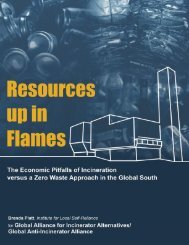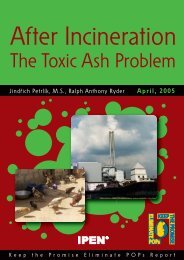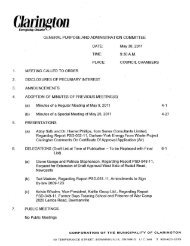A City Committed to Recycling Is Ready for More
A City Committed to Recycling Is Ready for More - Durham ...
A City Committed to Recycling Is Ready for More - Durham ...
- No tags were found...
You also want an ePaper? Increase the reach of your titles
YUMPU automatically turns print PDFs into web optimized ePapers that Google loves.
The recycling rate <strong>for</strong> this curbside collection from homes, hotels and the city’s 5,000<br />
restaurants is considerably lower than the overall rate, Mr. Reed said, in part because the<br />
rates on other waste streams — construction debris or material, like batteries and compact<br />
fluorescent bulbs, that the public brings in <strong>to</strong> special centers — is much higher.<br />
Much of the concrete from demolished buildings, <strong>for</strong> instance, is recycled in new sidewalks.<br />
Another recycling stream is born of the community’s design sensitivities. “People are doing<br />
very well here,” Mr. Reed said. “They remodel, and they paint. On Thursdays, Fridays and<br />
Saturdays, people line up <strong>to</strong> bring us paint” at a facility built <strong>for</strong> the purpose.<br />
“We separate it in<strong>to</strong> flat and latex, screen it <strong>to</strong> take out the chunks, and blend it in 55-<br />
gallon drums,” he said.<br />
The three resulting colors — off-white, beige and green — are packed in five-gallon tins and<br />
sent <strong>to</strong> local nonprofit organizations, schools or charitable institutions in Mexico.<br />
Norcal’s subsidiaries handle 3,545 <strong>to</strong>ns of waste a day in San Francisco, out of about 7,800<br />
generated citywide, Mr. Reed said. About 55 percent of Norcal’s <strong>to</strong>tal goes <strong>to</strong> the landfill;<br />
the rest is recycled. These figures become part of the calculation of the city’s overall<br />
diversion rate of 70 percent, which is the figure it just reported <strong>for</strong> 2006.<br />
As John Sitts, of the state’s integrated waste management board, said, “the diversion rate<br />
includes recycling, composting and source reduction” — the last term representing<br />
“everything businesses and residents do <strong>to</strong> reuse things rather than throwing them out.”<br />
The Los Angeles region most recently reported a 59 percent diversion rate, a number still<br />
being audited by state regula<strong>to</strong>rs. San Jose, at 62 percent, claims the best-in-class crown<br />
<strong>for</strong> cities of 900,000 or more. Statewide, the figure <strong>for</strong> 2006 was 54 percent.<br />
With the exception of Chicago,<br />
which boasted a 55 percent<br />
rate in 2006 — the most<br />
recent year <strong>for</strong> which national<br />
comparisons are available —<br />
Eastern and Midwestern cities<br />
lagged well behind their<br />
Cali<strong>for</strong>nia counterparts.<br />
According <strong>to</strong> the most recent<br />
annual survey of the trade<br />
magazine Waste News, in<br />
2006 New York <strong>City</strong> was at<br />
30.6 percent, Milwaukee at 24<br />
percent, Bos<strong>to</strong>n at 16 percent<br />
and Hous<strong>to</strong>n at 2.5 percent.<br />
San Francisco’s system is<br />
being noticed overseas. Mr.<br />
Blumenfeld’s calendar is full of<br />
meetings with officials from<br />
Germany and China, most of<br />
whom visit Norcal’s facilities,<br />
including the food-waste<br />
composting centers.<br />
His visi<strong>to</strong>rs are learning, Mr.<br />
Blumenfeld said, that “you can<br />
recycle almost anything.”






